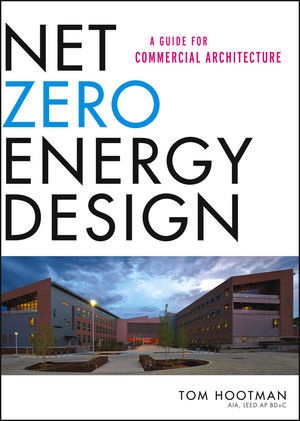En savoir plus
Informationen zum Autor TOM HOOTMAN, AIA LEED AP BD + C, is an architect and the Director of Sustainability at RNL, a global design firm specializing in sustainable design for the built environment. Hootman provides leadership and guidance to RNL's sustainable project work, design standards, staff education, research, and outreach. Tom has worked on several net zero energy design projects, including the NREL Research Support Facility. Klappentext Conveniently organized and packed with robust technical content and clear explanations of key principlesWritten by an architect who is the director of sustainability at a global architecture firm, Net Zero Energy Design is a practical guide for architects and related construction professionals who want to design and build net zero energy commercial architecture. It offers no-nonsense strategies, step-by-step technical analysis, and valuable examples, in addition to developed case studies. With a focus on application in a variety of building types and scales, the book also develops a broad-based understanding of all the integrated principles involved in achieving net zero energy.This book is an indispensable resource for anyone venturing into net zero energy design, construction, and operation, and it also serves as an excellent resource on a variety of sustainable design topics. Important features include:* Organization based upon the commercial building delivery process* Robust technical content for use in actual project applications* Analysis examples that demonstrate key technical principles* Plenty of design data for use as a valuable design resource* Abundant and sophisticated information graphics and color illustrations and photographs* A distinct design focus on the content that inspires adoption of principles into projects Zusammenfassung This book provides architects and construction professionals with complete guidance on how to design and build net zero commercial architecture. With a focus on application in a variety of building types and scales, the book helps readers develop a thorough understanding of all the integrated principles involved in achieving net zero energy. It offers practical strategies, step-by-step technical analysis, valuable examples, developed case studies, and numerous color graphics and photographs, making it an indispensable guide for anyone venturing into net zero energy design, construction, and operation. Inhaltsverzeichnis Acknowledgments IX In Introduction xiii My Net Zero Energy Journey XIII How To Use This Book xi v OV Chapter 1: Net Zero Energy Building Overview 1 The Case for Net Zero Energy Buildings 1 Defining Net Zero Energy 4 Classifying Net Zero Energy Buildings 10 Alternative Approaches to Net Zero Energy 12 Certifying Net Zero Energy Buildings 15 Building Industry Research and Trends 16 Building Industry Programs 19 Building Industry Codes and Regulations 20 Building Rating and Energy Labeling Systems 23 PC Chapter 2: Project Conception and Delivery 27 The Net Zero Energy Objective 27 Project Conception 36 Project Planning 40 Project Team Selection 44 Delivery Methods 49 Risks and Rewards 53 IP Chapter 3: Integrated Process 57 Integrated Delivery and Management 57 Project Delivery Phases 63 Integrated Design Methods 69 Building Energy Modeling 73 En Chapter 4: Energy 89 Energy Basics 89 Energy Use Intensity 102 Energy Targets 109 Energy and Thermal Comfort 125 DF Chapter 5: Design Fundamentals 133 Energy Design Conditions 133 Climate Assessment 133 Site Assessment 158 Building Massing and Geometry 166 Building Type and Zoning 177 PA Chapter 6: Pa ssive Architecture 183 Passive Design 183 Desig...

